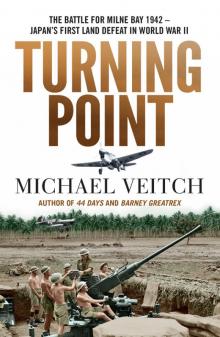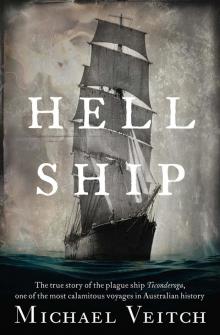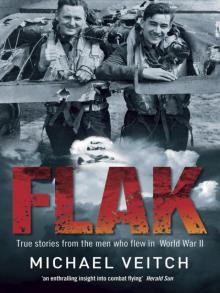- Home
- Michael Veitch
Turning Point Page 3
Turning Point Read online
Page 3
The next day, 12 June, the men of the 46th US (General Service) Engineering Regiment, who had arrived from Texas only a month or two earlier and were still adjusting to life in Townsville, were addressed by their commanding officer. The men of E Company, he announced, should begin packing immediately, as they would be getting into action somewhat earlier than the rest of the battalion.
Just hours later, they found themselves walking up the gangway of the Bontekoe, a freighter of the old colonial Royal Packet Navigation Company or KPM line; it was one of 29 such vessels which had escaped to Australia after the fall of the Dutch East Indies. Manned by Dutch and Javanese crews, the ad hoc flotilla would form a major part of a vital supply line between Australia and the south-west Pacific, motoring tirelessly between the mainland and Milne Bay, and beyond.
Five of KPM’s ships would be lost during the fight for Papua. US private Walter Wanielista later recalled his first encounter with the ship:
How E Company was selected to be the chosen one, only the Lord knows – a drawing or a dart board perhaps? Anyway, we left for Port Moresby, but of course at that time no one knew where we were headed, and even if they mentioned New Guinea our geography was not that good.
In the Bontekoe’s holds were some of the engineering equipment with which they were expected to build an airfield: two medium D4 Cat bulldozers (both in need of repair), two graders, four small dump trucks, one cargo truck and a power shovel. More, the men were told, would be picked up en route.
Beside them, a similar but considerably older Dutch KPM ship, the Karsik, was busy loading the experienced Australian troops of 9th Battery, 2/3rd Light Anti-Aircraft Regiment (LAA). While the ageing ship took no time to be awarded the nickname ‘Spit, Fart and Cough’, the men were more impressed with the Dutch crew’s liberal liquor policy, which did much to assuage their grievances.
The 2/3rd had already seen a great deal of the war in the Middle East, having accounted for over 100 enemy aircraft destroyed, but 162 of their men had either been killed or taken prisoner. Hauled back to Australia to meet the Japanese threat, they had docked in Adelaide only the previous March, with jungle training in Queensland beginning a few weeks later. Now they were heading off again to fight a very different kind of war – but to where, exactly, none had the slightest idea.
After an uneventful few days at sea, the Bontekoe and Karsik pulled into Port Moresby’s harbour, where every man onboard suddenly felt decidedly closer to the war. That afternoon, eighteen Japanese bombers flew overhead, accompanied by the booms of the heavy anti-aircraft guns which opened up on them from around the harbour. More men and equipment was loaded onto the two ships, with the Karsik taking on several 25-pounder heavy field guns and eight Bofors anti-aircraft pieces of the 2/3rd LAA; several were not lowered into the ship’s holds but placed straight on the Karsik’s upper deck, where the men of C Troop were ordered to secure them for immediate action. Just as well, as the wail of air raid sirens soon rang out once again across the harbour. The dock workers, it was observed, barely broke stride: Japanese air raids on Moresby had become a daily – sometimes several times daily – occurrence.
Also making their way onto the Karsik at Moresby were several hundred men of the 14th Brigade’s 55th Battalion, whose role, at least on paper, would be to provide manual labour and security for the construction personnel. As militia, the 55th were not permitted to serve in areas outside Australia’s jurisdiction. This, however, was the Territory of Papua, under Australian rule since its annexation by Queensland in the 1880s. To the men boarding the Karsik that morning, however, as Japanese bombers prowled overhead, the distinction appeared academic.
It had been a bewildering few weeks for the men of the 55th. Since December 1941 they had been deployed mainly in coastal defence roles around Newcastle in New South Wales, but as the situation to the north deteriorated, they were ordered in May to move significantly closer to danger at Port Moresby. Here, their weapons were shovels rather than rifles, and they were kept busy building and manning harbour and airfield defences. Yet they noticed that they weren’t spending much time in actual training. Three companies of the battalion – A, C and a section of E (which had at least had some training on antiquated First World War Vickers machine guns) – were informed in mid-June that they would soon be on the move, though none yet knew their new location.
For three days the ships loaded men and material at Port Moresby, interrupted by frequent Japanese air attacks. Up to twenty pieces of the American engineers’ equipment would, for the time being, be left to languish on the dock while another ship was sought to take it forward. In its place, it was noted with alarm, was loaded a good deal of highly flammable aviation fuel and ammunition.
Also preparing to depart was the elegant passenger and cargo vessel Macdhui, which had already had an eventful war since being painted grey and pressed into service the previous year. In January she evacuated hundreds from the fallen fortress of Rabaul, and was now regularly running supplies between Townsville and Port Moresby. Lying at anchor in the harbour there on 18 June, the Macdhui was hit by four bombs from Betty bombers, which ignited her holds full of drums of aviation fuel. Fire quickly took hold before she rolled over and sank half a mile offshore, taking ten merchant navy sailors with her. Waiting to leave, the gunners, troops and engineers looked on helplessly as smoke from the Macdhui billowed across the harbour.
Although unused to handling weaponry, another group also preparing to sail would play a vital part in the coming battle: the radar operators of No. 37 Radio Direction Finder (i.e. radar) Unit. With their training thus far having been entirely theoretical, and delivered in stifling Port Moresby classrooms, they had not even sighted their equipment until, brand-new and still in its crates, it was loaded onto the ship alongside them. At least, at Moresby they been given some rudimentary rifle practice, if only, as one of their number remarked, ‘to show us from which end the bullets emerged’.
Finally, just before dawn on 24 June, the four-ship convoy of the Bontekoe, Karsik, plus two escorting vessels, the corvette Ballarat and the destroyer Warrego, set sail for Milne Bay. Only now was their destination revealed to the engineers, gunners and infantry on board, but as the operation was referred to only by its codename, Fall River, no-one was any the wiser. As Sergeant Wilbert Block of the US 46th Engineer Battalion recalled:
We headed southwest. Everyone was ordered to stay below deck. No one was allowed topside. We sailed all that day and night. The skipper had ordered several ‘Abandon Ship’ drills, but there were not enough lifeboats. We had to wear our life jackets at all times. All this made us wonder what we were getting into. We were never told where we were going.
As recorded in their official history, the 2/3rd Light Anti-Aircraft Regiment’s gunners onboard the Karsik remembered the trip as somewhat surreal:
The Dutch skipper weighed about twenty stone and drank Bols gin in a huge glass. There was a Dutch engineer, an Australian radio officer, and a deck crew who from the bosun down were Malay.
Twenty-four hours after leaving Moresby, at first light, the convoy approached the narrow passage which guarded Milne Bay’s southern entrance, China Strait, passing close by the local administrative centre of Samarai, or what was left of it. Now, it was largely abandoned, with much of its little town reduced to piles of blackened beams and rusting corrugated iron. The previous January, after a Japanese air raid, it was decided to execute a scorched-earth policy on Samarai to deny it to the Japanese, who, it was correctly suspected, wanted its port, harbour and seaplane facilities for themselves. For the sailors on the ships of the convoy heading into the bay, however, it was a depressing sight.
It was in fact the forlorn sight of Samarai that filled the crew of the Karsik with sufficient foreboding for them to stage a near mutiny when they signalled to the rest of the convoy their reluctance to enter the bay. ‘Nobody knew what was in there,’ recorded the diary of a leading seaman travelling with them. It was not until her escorting vessel, HMAS
Warrego, trained her guns on the recalcitrant merchantman and threatened to sink her that she grudgingly complied.
Sailing due west for the next five hours, the convoy finally arrived at Gili Gili, at Milne Bay’s western end. Barely a week earlier, a handful of Australian and Papuan labourers, under the guidance of Captain Mackendrick (Mac) Rich of ANGAU, had begun construction of a rudimentary wharf and pontoon.
Rich himself proved an invaluable asset to the Australian forces at Milne Bay and beyond. Born to missionary parents on Samarai in 1903, he was at an early age fully fluent in several local dialects, and at twenty began a career in Papua’s civil administration. By the mid-1930s he was district officer at Kokoda, at which time he also became Papua’s first fully licensed radio operator. When the war came, his talents were recognised quickly by ANGAU, which in early 1942 placed him in charge of the Eastern District of Papua, as well as conferring on him the army rank of captain. In his memoirs, Rich recalled the visit from a flustered major in Port Moresby charged with overseeing his hasty transformation from civilian to officer in the Australian Army:
He brought some military kit, swags, water bottles, blankets and clothing but no badges of rank and we were forced to cast our own ‘pips’ from lead, which hung more like sinkers from our epaulets and likely to smite one on the jaw if one turned suddenly.
Sergeant Block of the US 46th Engineers recalled his first sight of Gili Gili from the top deck of the Bontekoe:
We stopped in the bottom of a horseshoe type bay, not more than a quarter mile from shore. The skipper did not drop anchor – just stopped. Shortly, native canoes came out to us and a couple of lifeboats were being lowered by the ship’s crew.
The Karsik, with its nervous crew, was the first vessel to pull up to the small wharf, which, though newly completed, could only accommodate one vessel at a time. As the risk of their discovery by Japanese reconnaissance aircraft was high, waiting patiently for one’s turn to come in and dock would simply not do. Block continued:
The platoon commander and some of us went ashore to look for deep water as close to the shore as possible. The natives knew the shoreline and took us to such a place. This area had no beaches – where the trees stopped, the water began and went straight down for 30 feet. The Skipper moved his boat right up to the trees, tied onto them and pulled himself in.
Even at the wharf, stores were unable to be loaded directly into trucks and vehicles, making the entire unloading procedure long and exhausting. Out in the bay, the Warrego made constant anti-submarine sweeps; overhead, Beauforts from 100 Squadron, based at Moresby, also patrolled, an early indication of the deep cooperation between Australian ground and air forces that would exemplify the campaign. All ears were alert to the sound of Japanese aircraft, but to the relief – and not a little surprise – of everyone, the unloading proceeded unobserved by the enemy.
Three days were needed to complete the initial unloading, a task that would have been unachievable without the labour of 250 local villagers. Negotiating the recruitment of labourers was a delicate business requiring tact, diplomacy and an appreciation of Papuan village life. With neither the war nor the Allied cause being their own, it was appreciated early that the local people needed to be won over rather than coerced into offering their support. The brutality of the Japanese towards many Papuans played into the Allies’ hands, but their goodwill and cooperation were nonetheless not taken for granted. Loyalties and alliances among Papuans coalesced around individual relationships rather than larger causes, and ANGAU officers such as Mac Rich made securing such loyalties a priority.
Papuan villages were small but tight-knit communities governed by complex social and family structures and hierarchies. In a village of 100 individuals, it was estimated that no more than twenty would be able-bodied males, upon whom the remainder of the community – old people, women and children – relied. Removing too many males for labouring duties would thus deprive the village of those capable of hunting, and canoe and house building, as well as the ceremonial obligations that were essential to village life.
Impressed upon all Australian personnel was the need to respect the villagers, with threats of severe punishment for those who did not, as the Standing Orders for 61 Battalion outlined:
It is imperative that troops do not commit acts which may, in the slightest degree, alienate the natives and at the same time embarrass the ANGAU officers in carrying out their duties.
Village gardens and plantations were to be respected, all labour was to be paid for, and under no circumstances were Papuan women to be molested, or even approached. Directives concerning the Australian troops’ penchant for nude bathing were also issued:
It is only by retaining the respect of the natives of this country that we hope for the cooperation in the task we have before us. The white population of New Guinea have built up this respect for the white man and it is for us to see that by no action our prestige is lowered. For a white man to expose his naked body before a native means that we all as a race lose face in the eyes of a native and it is therefore essential if troops bathe in the nude that a sentry MUST be posted to prevent natives approaching. Where available, trunks must be worn.
In large part, the diplomacy paid off, as ANGAU officer Lieutenant Jim Ross recalled:
When [the local people were] called upon to work, the response was gratifying. This in no small way was a result of the confidence they had in the leadership given by the administration [ANGAU] personnel whom they had come to know.
Traditional attitudes towards the Papuan people were nevertheless deep-set, as one air force anecdote regarding 76 Squadron’s CO, Peter Turnbull, attests. Fresh from his assimilation lecture in Townsville, upon arrival in Port Moresby, the veteran squadron leader grabbed the nearest local boy he could find to attend to his domestic needs. ‘Eh! Boy, these big boots, clean ’em, quicktime – yes?’ he said, attempting to speak the local pidgin. ‘Certainly, sir,’ replied the boy in perfect English. ‘Do you prefer that I use Kiwi or Nugget?’
Over a thousand village men and women from the greater Milne Bay area were, at various stages, employed by the army’s engineers, each man earning no more than ten shillings a month, with the first task being the construction of a wharf at Gili Gili. In this, their exertions astounded even their white observers. Lieutenant Hugh Griffin of the 55th Battalion was one of those first to arrive, and remembered the ingenuity of the local engineers and labourers, both male and female:
There were no ropes or picks available, but a few shovels and we managed to acquire sufficient poles for the job. The poles were guyed with native vines used as ropes and rocked into the sea bed forming a framework similar to a pig sty. This frame was then filled with coral and sand by a chain of about eighty women carrying baskets on their heads from a nearby sandy area … even the children joined in bringing lumps of coral in their canoes to add as filling.
Large yellow-handled ‘hoop iron’ knives were used to slash tough kunai grass and small trees to prepare roads and landing areas, and Papuan carpenters constructed and transported the wharf’s foundations and decking. In only four days the first wharf was complete, made ready for use just twelve hours before the arrival of the convoy.
At first light on 26 June, it was with great relief that the crews of the Karsik and Bontekoe, their holds empty, pulled away from the little wharf at Gili Gili and headed east again, towards the open sea. It was only now, however, after their arrival at this strange dead end at the bottom of the world, that the American engineers and Australian infantrymen and gunners could grapple with the scale of the task that lay before them.
CHAPTER 4
THE BUILD-UP
Major Athelstane Garfield Margetts of the 2/3rd Light Anti-Aircraft Regiment, newly appointed as the temporary commander of the so-called Fall River Garrison, in no way relished the job he had been given, and was not in the least certain that it was even achievable. Once again he read over his secret orders, titled ‘Fall River Operational Instruct
ions No. 17, June 15, 1942’, which stated blandly:
The role of the garrison will be:
(a) to construct the aerodrome
(b) A.A. defence of aerodrome
(c) ground defence of the area against paratroops or small raiding parties by land or sea
(d) provision of such guards as may be required for the protection of equipment supplies, etc
(e) in the event of an overwhelming force being brought to bear against the garrison, it will inflict maximum loss on the enemy before withdrawal …
The ‘garrison’ with which he was expected to achieve all this and more comprised a mixed bunch of US and Australian units – or parts thereof – including his own light anti-aircraft men, the under-resourced US 46th Engineer Battalion, six platoons of the Australian 55th militia, a single platoon of the US 101st Coast Artillery Battalion armed with eight half-inch guns, a couple of companies from the 14th Infantry Brigade, a signals company from Western Australia, a US Hospital detachment, an HQ company, plus several others, none of which boasted any jungle fighting experience, nor any time spent in the tropics. With this he was expected to oversee the creation, from scratch, of an airstrip capable of supporting the most modern fighter and bomber aircraft in the world, which would later form the basis of a military citadel, carved out of a 426-acre coconut plantation in the middle of a malaria-ridden jungle, with the enemy at any moment expected to land in force and try to take it. And all this was to be achieved under a cloak of the strictest secrecy in just 25 days.

 Turning Point
Turning Point Heroes of the Skies
Heroes of the Skies The Forgotten Islands
The Forgotten Islands Hell Ship
Hell Ship Flak
Flak Fly
Fly